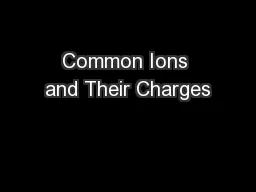/


A mastery of the common ions their formulas and their charges is essential to success in AP Chemistry You are expected to know all of these ions on the first day of class when I will give you a q ID: 365217
Download Pdf The PPT/PDF document "Common Ions and Their Charges" is the property of its rightful owner. Permission is granted to download and print the materials on this web site for personal, non-commercial use only, and to display it on your personal computer provided you do not modify the materials and that you retain all copyright notices contained in the materials. By downloading content from our website, you accept the terms of this agreement.
Common Ions and Their Charges A mastery of the common ions, their formulas and their charges, is essential to success in AP Chemistry. You are expected to know all of these ions on the first day of class, when I will give you a quiz on them. You will always be allowed a periodic table, which makes indentifying the ions on the left automatic. For tips on learning these ions, see the opposite side of this page. From the table: Ions to Memorize Cations Name Cations Name Hydrogen Ag Silver Lithium Zn Zinc Sodium Hg Mercury(I) Potassium NH Ammonium Rubidium Cesium Beryllium Magnesium NO Nitrite Calcium NO Nitrate Barium SO Sulfite Strontium SO Sulfate Aluminum HSO Hydrogen sulfate (bisulfate) OH Hydroxide Anions Name Cyanide Hydride PO Phosphate Fluoride HPO Hydrogen phosphate Chloride H Dihydrogen phosphate Bromide NCS Thiocyanate Iodide CO Carbonate Oxide HCO Hydrogen carbonate (bicarbonate) Sulfide ClO Hypochlorite Selenide ClO Chlorite Nitride ClO Chlorate Phosphide ClO Perchlorate Arsenide BrO Hypobromite Type II Cations Name BrO Iron(III) BrO Bromate Iron(II) BrO Perbromate Copper(II) Hypoiodite Copper(I) iodite Cobalt(III) iodate Cobalt(II) Periodate Tin(IV) C Acetate Tin(II) MnO Permanganate Lead(IV) Cr Dichromate Lead(II) CrO Chromate Mercury(II) O Peroxide C Oxalate NH Amide BO Borate S Thiosulfate Tips for Learning the Ions These are ions can be organized into two groups. 1. Their place on the table suggests the charge on the ion, since the neutral atom gains or loses a predictable number of electrons in order to obtain a noble gas configuration. This was a focus in first year chemistry, so if you are unsure what this means, get help BEFORE the start of the year. a. All Group 1 Elements (alkali metals) lose one electron to form an ion with a 1+ charge b. All Group 2 Elements (alkaline earth metals) lose two electrons to form an ion with a 2+ c. Group 13 metals like aluminum lose three electrons to form an ion with a 3+ charge d. All Group 17 Elements (halogens) gain one electron to form an ion with a 1- charge e. All Group 16 nonmetals gain two electrons to form an ion with a 2- charge f. All Group 15 nonmetals gain three electrons to form an ion with a 3- charge Notice that cations keep their name (sodium ion, calcium ion) while anions get an -ide ending (chloride ion, oxide ion). 2. Metals that can form more than one ion will have their positive charge denoted by a roman numeral Polyatomic Anions Most of the work on memorization occurs with these ions, but there are a number of patterns that can greatly reduce the amount of memorizing that one must do. 1. ate anions have one more oxygen then the ite ion, but the same charge. If you memorize the ate ions, then you should be able to derive the formula for the ite ion and vice-versa. a. sulfate is SOb. nitrate is NO, so nitrite has the same charge but one less oxygen (NO2. If you know that a sufate ion is SO then to get the formula for hydrogen sulfate ion, you add a hydrogen ion to the front of the formula. Since a hydrogen ion has a 1+ charge, the net charge on the new ion is less negative by one. a. Example: HPO H phosphate hydrogen phosphate dihydrogen phosphate 3. Learn the hypochlorite perchlorate series, and you also know the series containing iodite/iodate as well as bromite/bromate. a. The relationship between the ite and ate ion is predictable, as always. Learn one and you b. The prefix hypo means under or too little (think hypodermic, hypothermic or hypoglycemia) i. Hypochlorite is under chlorite, meaning it has one less oxygen c. The prefix hyper means above or too much (think hyperkinetic) i. the prefix per is derived from hyper so perchlorate (hyperchlorate) has one more oxygen than chlorate. d. Notice how this sequence increases in oxygen while retaining the same charge: ClO ClO ClO hypochlorite chlorite chlorate perchlorate